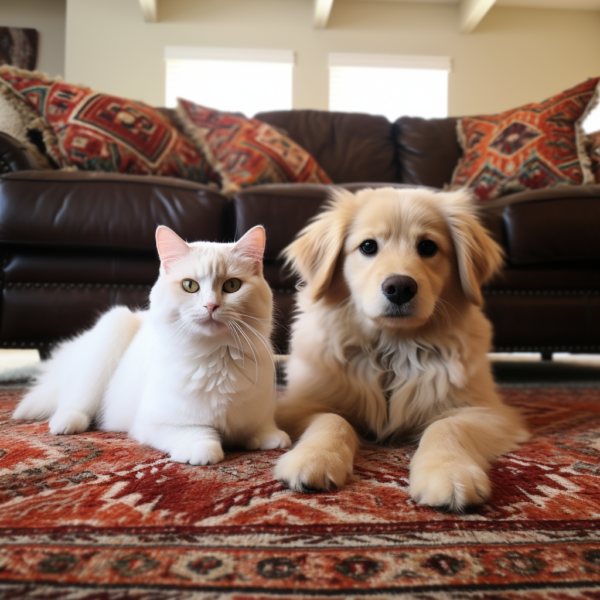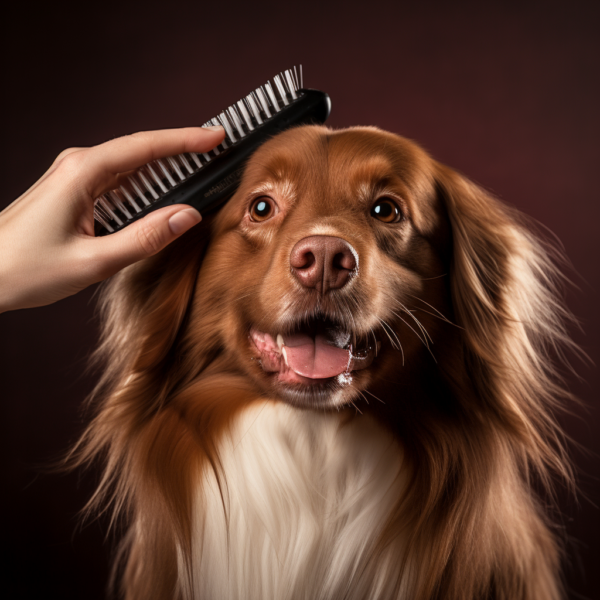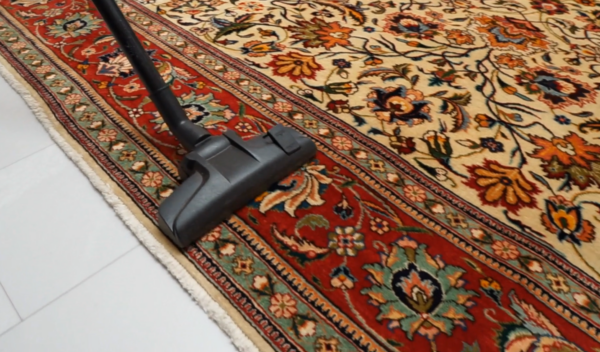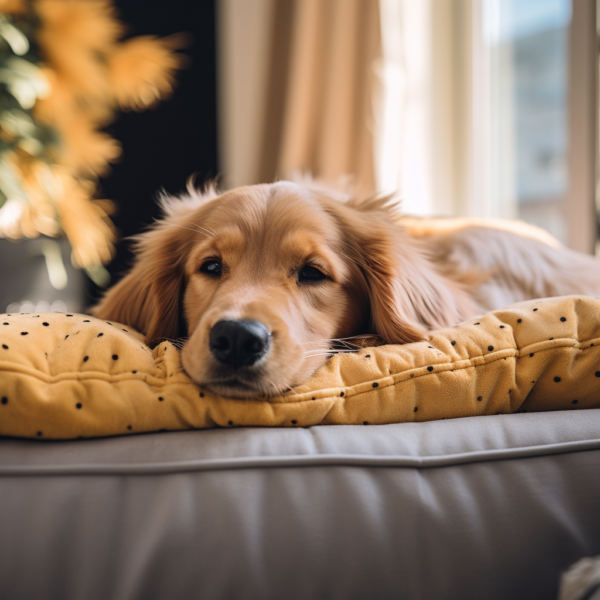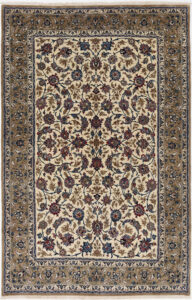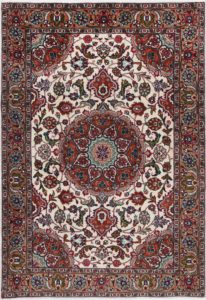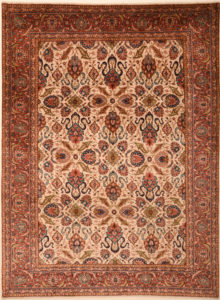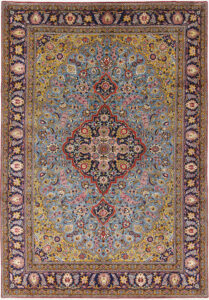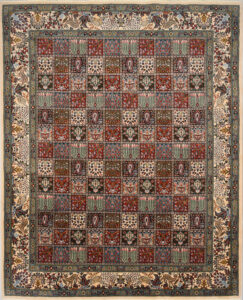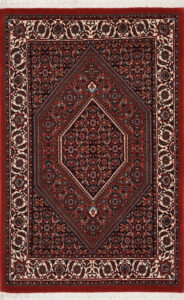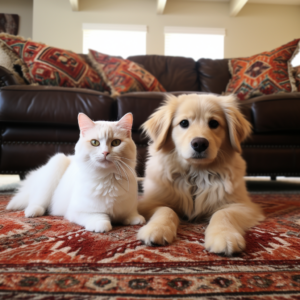Persian rugs are a luxurious addition to any home, but pet owners might find themselves in a constant battle with pet hair on oriental rugs, stains, and odors. The intricate designs and delicate fibers of these rugs require special care to maintain their beauty and longevity.
As a fellow pet owner, we know how challenging it can be to keep our rugs looking pristine while providing a comfortable environment for our beloved pets.
Fear not, fellow pet lovers! In this blog post, we’ll share effective techniques to prevent pet hair on oriental rugs buildup, quick and easy pet hair removal methods, deep cleaning solutions for stubborn hair, and ways to deal with pet stains and odors on your precious Oriental rugs.
Let’s restore the harmony between our rugs and furry companions!
Key Takeaways
Prevent pet hair buildup on Oriental rugs by regular grooming and using furniture covers.
Remove pet hair from Oriental rugs with vacuuming, lint rollers, or rubber squeegees.
Address stubborn pet stains and odors with spot cleaning, natural remedies, or professional services. Protect the rug from future damage.
Precautionary Measures
A. Training and Designating
Training your pets to stay off your valuable Persian rug is a proactive step that can save you a lot of hassle in the long run. This process can be quite straightforward with the right techniques and consistency. Here’s an in-depth look at how to accomplish this:
1. Positive Reinforcement: Use positive reinforcement to train your pets to avoid your rug. Whenever your pets behave well and avoid the rug, reward them with treats, praise, or affection. Positive feedback encourages your pets to associate good behavior with rewards, making them more likely to follow your guidelines.
2. Consistent Commands: Establish consistent commands like “off” or “leave it” to indicate that your pets should stay away from the rug. Be patient and repeat these commands regularly until they understand what’s expected of them. Consistency is key in reinforcing the message.
3. Training Sessions: Set aside dedicated training sessions to work with your pets on rug etiquette. During these sessions, guide your pets away from the rug and practice commands. Keep these sessions short and engaging, ensuring your pets don’t become bored or frustrated.
4. Physical Boundaries: If your pets still struggle to resist the allure of your rug, consider setting up physical barriers like baby gates to restrict access to the rug. These barriers act as visual cues for your pets, making it clear that the rug is off-limits.
5. Redirect Their Attention: Create enticing pet-friendly zones within your home where your pets can play, rest, and relax. Fill these spaces with their toys and bedding to redirect their attention away from your rug.
B. Preventive Measures
In addition to training your pets, preventive measures add an extra layer of protection to your Persian rug. These measures are designed to deter your pets from approaching the rug in the first place:
1. Anti-Scratch Sprays: Anti-scratch sprays are specially formulated to discourage pets from scratching, clawing, or nibbling on your rug. These sprays are safe for pets and contain scents or tastes that are unappealing to them. Apply the spray to the edges of your rug or any areas your pets typically target.
2. Pet Repellent Mats: Pet repellent mats are clever devices that use mild static pulses or sounds to deter pets from stepping onto a particular area. You can place these mats strategically on your rug to create an invisible barrier. Most pets quickly learn to avoid these areas to avoid the discomfort or noise.
3. Rug Covers: When your rug is not in use or during times when you can’t actively supervise your pets, consider using a rug cover. This temporary barrier helps protect your rug from pet-related incidents and minimizes the need for constant vigilance.
4. Double-Sided Tape: Placing double-sided tape on the edges of your rug can be an effective deterrent. Pets typically dislike the texture of the tape on their paws, making them less likely to approach the rug.
By combining training with preventive measures, you’ll create a pet-friendly environment where your Persian rug is safeguarded from potential damage. These strategies not only preserve the rug’s integrity but also make for a harmonious coexistence between your pets and your home’s aesthetic.
Regular Maintenance
Preventing Pet Hair Buildup on Oriental Rugs
An ounce of prevention is worth a pound of cure, as the saying goes. Maintaining the appearance and longevity of your Oriental rugs involves minimizing pet hair buildup. A few proactive steps can make a significant difference in reducing the accumulation of pet hair on your rugs.
Regular grooming of your pets can significantly reduce the amount of hair that ends up on your rugs. Here are some tips to help you with pet grooming:
Brush your pets regularly to remove excess hair from their coats before it has a chance to settle on your rug.
Bathe your pets regularly to keep their coats clean and healthy, reducing excessive shedding.
Use a pet hair remover or vacuum cleaner specifically designed for pet hair to remove any hair that does end up on your rug.
By following these grooming tips, you can prevent pet hair, including stubborn hair like dog hair, from becoming entrenched in the fibers of your rug and keep your home clean and hair-free.
To protect your rugs even further, consider using pet hair-resistant furniture covers. These covers are designed to resist pet hair, keeping your furniture and rugs free of pet hair. Lastly, placing your Persian or Oriental rugs in low-traffic areas, such as bedrooms or living rooms, can minimize pet hair accumulation.
Quick and Easy Pet Hair Removal Techniques
Having covered prevention, we will now explore several quick and easy techniques for pet hair removal from your Oriental rugs. These methods are perfect for regular maintenance and can be performed by anyone, even those who aren’t particularly handy.
We’ll be exploring three simple techniques: vacuuming with a brush attachment, utilizing lint rollers, and rubber squeegees. Each method has its own merits and is suitable for different situations. We will examine each technique in detail to understand how they can assist in maintaining your Oriental rugs free from pet hair.
Vacuuming
Vacuuming your Oriental rug regularly with a brush attachment can help remove pet hair and keep the rug looking fresh and clean. The choice of vacuum model plays a significant role in effective pet hair removal; some suitable options include the Bissell Featherweight Stick Lightweight Bagless Vacuum and the Kenmore Elite 21814 Canister Vacuum.
To vacuum your Oriental rug without causing damage, follow these steps:
Use low suction and avoid using the brush or bristles on the vacuum.
Vacuum in the width direction of the rug, adhering to the east to west direction, to loosen and extract pet hair more efficiently.
Vacuuming can also help remove urine particles from the rug fibers.
Lint Rollers
Lint rollers are a convenient and effective way to remove pet hair from Oriental rugs, especially for small areas or quick touch-ups. The adhesive surface of lint rollers easily collects and retains pet hair, allowing for effortless removal from rugs. Many consumers find lint rollers to be a quick and effective solution for pet hair removal.
However, there are some drawbacks to using lint rollers on Oriental rugs. They can be abrasive and may lift bits of loose fibers from the rug. Furthermore, lint rollers are not as effective on large surfaces and may not remove all pet hair. Traditional lint rollers also require frequent replacement, which can be inconvenient. Using fabric softener during the washing process can help reduce the amount of pet hair on the rug, but it’s not a perfect solution.
Rubber Squeegees
Rubber squeegees can be used to lift and collect pet hair from Oriental rugs, making it easier to remove and dispose of the hair. The rubber material of the squeegee has natural gripping properties that facilitate the gathering and trapping of pet hair from various surfaces, such as carpets, rugs, and upholstery.
Using a rubber squeegee on your Oriental rug involves:
Holding the squeegee at a slight angle and firmly pressing it against the rug.
Using long, sweeping motions to move the squeegee across the rug in one direction.
The rubber material will attract and collect the pet hair, forming clumps that can be easily removed and disposed of.
Rubber squeegees are easy to clean and are a cost-effective solution for pet hair removal.
Deep Cleaning Solutions for Stubborn Pet Hair
Sometimes, despite our best efforts, pet hair can become deeply embedded in our Oriental rugs. In these cases, deep cleaning solutions are necessary to tackle stubborn pet hair. These methods are more intensive and may require specialized equipment or professional assistance.
We will introduce three deep cleaning solutions for stubborn pet hair in this segment: professional rug cleaning, steam cleaning, and utilizing specialized rug brushes. Each method offers a different level of cleaning power, and the best option depends on the severity of the pet hair problem and the specific needs of your rug.
Professional Rug Cleaning
Professional rug cleaning services can effectively remove pet hair, stains, and odors from Oriental rugs, ensuring their longevity and beauty. These services utilize specialized cleaning products and techniques to ensure the removal of pet hair without damaging the rug’s natural fibers.
Hiring a professional rug cleaner offers several advantages, such as:
Elimination of allergens and bacteria
Extending the lifespan of your rugs
Eradicating stubborn stains
Enhancing indoor air quality
Saving time and effort
It is generally recommended that Oriental rugs with pet hair, stains, and odors be professionally serviced every two years.
Steam Cleaning
Steam cleaning can help with:
Loosening and removing stubborn pet hair from Oriental rugs
Sanitizing and refreshing the rug fibers
Penetrating deep into the rug and softening the hair for easier removal
Eliminating any bacteria or allergens in the pet hair
Although steam cleaning can be effective at removing pet hair, it is not recommended for Oriental rugs, as it may potentially cause harm to the rugs and the floors. Instead, consider alternative methods such as vacuuming, rubber squeegees, or baking soda for pet hair removal.
Specialized Rug Brushes
Specialized rug brushes can be used to gently remove embedded pet hair from Oriental rugs without causing damage to the delicate fibers. Some of the most effective specialized rug brushes for pet hair removal include the Professional Rubber Pet Hair Removal Brush, the OXO FurLifter, and the Conliwell Rubber Broom Pet Hair Removal Tool.
To use a specialized rug brush, follow these steps:
Vacuum the rug to remove any loose pet hair.
Use the brush in a sweeping motion across the rug’s surface, focusing on areas where pet hair tends to accumulate, such as corners and edges.
Apply gentle pressure while brushing to effectively lift the pet hair from the rug fibers.
After brushing, vacuum the rug again to remove any loosened pet hair. Remember to clean the brush regularly to maintain its effectiveness.
Dealing with Pet Stains and Odors on Oriental Rugs
In addition to pet hair, pet owner often has to deal with pet stains and odors on their Oriental rugs. These accidents can be especially challenging to address without causing damage to the delicate fibers and colors of the rugs.
Identifying Common Pet Odors and Their Sources
To effectively combat pet odors that may linger on your cherished Persian rug, it’s crucial to understand where these unpleasant scents originate. Here, we’ll delve into some of the most common pet odor sources so you can tackle the issue at its roots.
1. Pet Accidents
One of the primary sources of pet odors on your rug is, of course, pet accidents. Whether it’s a little “surprise” from your puppy or a hairball from your cat, these incidents can leave lasting and sometimes pungent smells. Identifying and addressing these accidents promptly is key to preventing odors from setting in.
2. Pet Dander
Pet dander, tiny flecks of skin that naturally shed from your pets, can be a consistent source of odor. These minuscule particles can accumulate in your rug’s fibers over time, leading to a musty or stale scent. While dander is not always noticeable to the naked eye, it can have a significant impact on your home’s overall air quality.
3. Wet Fur
Pets may come in from the rain or play outside, bringing moisture and wet fur into your home. When your wet pet decides to rest on your rug, it can create a damp environment, fostering the growth of mildew and bacteria, resulting in an unpleasant odor.
4. Oil and Residue from Fur
Pets have natural oils on their fur, which can transfer to your rug when they come into contact with it. Over time, these oils and residue can accumulate, becoming a breeding ground for odor-causing bacteria.
5. Lingering Pet Odors from Outside
If your pets spend time outdoors and then return indoors, they may bring with them the scents of the outdoors, including dirt, grass, and various outdoor odors. These can transfer to your rug, causing it to absorb outdoor smells.
6. Pet Beds and Blankets
The bedding and blankets you provide for your pets can also accumulate odors. Pets spend a significant portion of their time on these items, and as they snuggle, nap, and groom themselves, odors from their fur and bodies can transfer to these fabrics. When your pets then rest on your rug, they may transfer these odors to the rug’s fibers.
7. Pet’s Favorite Play Area
If your pets have a specific area in your home where they play or spend a lot of time, this area may accumulate pet odors more quickly. Since pets tend to frequent their favorite spots, these areas often require more attention in terms of cleaning and odor control.
By identifying these common pet odor sources, you’ll be better equipped to tackle odors on your Persian rug. Once you understand where the smells are coming from, you can implement targeted strategies to eliminate them and keep your rug smelling fresh and clean.
Now, let’s explore several strategies for addressing pet stains and odors on Oriental rugs in this part, such as spot cleaning, employing natural remedies like vinegar and baking soda, and engaging professional cleaning services for stubborn or persistent stains. With this knowledge, you’ll be better prepared to tackle even the most stubborn pet stains and odors.
Spot Cleaning
Spot cleaning pet stains on Oriental rugs involves the following steps:
Begin by absorbing as much of the liquid as possible with paper towels or a clean, white cloth.
Combine one part vinegar with two parts warm water and gently dab the stain with the mixture.
Rinse out as much of the spill as possible.
Continue blotting until the stain is removed.
When spot cleaning pet stains, it’s important to test any cleaning solution on an inconspicuous area of the rug first to ensure it won’t cause damage. Commercial dry cleaning solvents or mild detergents specifically designed for rugs can also be used.
Natural Remedies
Natural remedies like vinegar and baking soda can be used to effectively remove pet stains, including pet urine and urine stains, and odors from Oriental rugs without causing damage to the fibers or colors. To use vinegar, mix one part vinegar with two parts water and gently dab the mixture onto a fresh urine stain. Blot the area with additional paper towels to remove the vinegar and any remaining urine.
For a more powerful odor remover, you can:
Sprinkle baking soda over the wet area of the rug and let it dry.
Once the baking soda is dry, vacuum it up to eliminate any residual odor.
Baking soda can also be applied to dry areas of the rug to remove lingering smells.
Professional Cleaning
Professional cleaning services can provide thorough and effective treatment for pet stains and odors on Oriental rugs, ensuring their longevity and beauty. These services use specialized cleaning products and techniques to remove pet stains and odors without damaging the rug’s fibers or colors.
Hiring a professional cleaning service offers several advantages, such as:
Complete eradication of pet stains and odors
Safeguarding against potential harm
Elimination of allergens and bacteria
Restoring the rug’s look
Thwarting mold growth
Professional cleaning services may be necessary for more serious damage and ingrained stains.
Tips for Protecting Your Oriental Rug from Pet Damage
Protecting your Oriental rug from pet damage is key to its preservation. The following tips can help you preserve your rug’s beauty and longevity while still providing a comfortable home for your furry friends.
Place your Oriental rugs in low-traffic areas, such as bedrooms or living rooms, to minimize pet hair accumulation. Using pet hair-resistant furniture covers can also help protect your rugs from pet hair. Regularly grooming your pets reduces shedding and hair buildup on your rugs. By implementing these simple tips, you can enjoy the beauty of your Oriental rugs while maintaining a pet-friendly home.
Summary
In conclusion, managing pet hair, stains, and odors on Oriental rugs can be a daunting task, but with the right techniques and strategies, it is achievable. Prevention is critical, so groom your pets regularly, use pet hair-resistant furniture covers, and place rugs in low-traffic areas to minimize hair buildup. For quick and easy pet hair removal, consider vacuuming, using lint rollers, or rubber squeegees. For stubborn pet hair, try professional rug cleaning, steam cleaning, or specialized rug brushes.
By following these guidelines and taking a proactive approach to pet hair and stain management, you can preserve the beauty and longevity of your Oriental rugs while providing a comfortable and inviting home for your furry companions.
Frequently Asked Questions
How do you get dog hair off an Oriental rug?
For removing dog hair from an Oriental rug, sprinkle baking soda over the carpet to loosen hair and remove odors before a thorough vacuuming. Alternatively, try using fabric softener mixed with warm water in an empty sprayer bottle and hoover up the excess hair.
How do you get cat hair out of an Oriental rug?
Use a rubber squeegee or rubber broom to collect the cat hair into clumps, then sprinkle some baking soda over the carpet and vacuum up the debris. This should help remove the pet hair from your Oriental rug.
How do you get pet urine out of Oriental rugs?
Remove pet urine from Oriental rugs by blotting up the liquid and then treating the stain with a mixture of white vinegar and water. Let this mixture sit for around 10 minutes before blotting it up again and then rinsing it with cold water. Refrain from using ammonia, bleach, or any other strong cleaning products.
How often should I vacuum my Oriental rug to reduce pet hair buildup?
Vacuuming your Oriental rug at least once a week is recommended to reduce pet hair buildup. If the rug is in a high-traffic or dusty area, you should vacuum more often.
Can I use a lint roller to remove pet hair from my Oriental rug?
Yes, lint rollers can be used to remove pet hair from Oriental rugs; however, they may not remove all pet hair and can be abrasive on delicate rug fibers.
